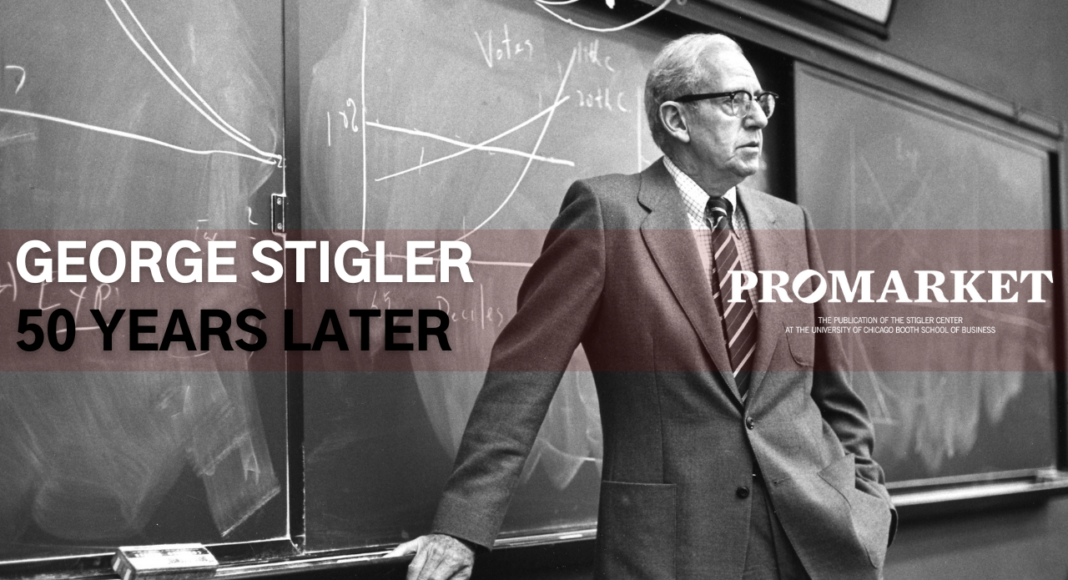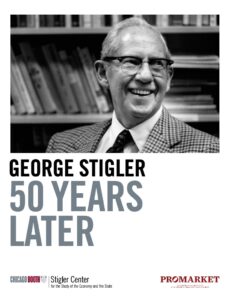To mark the 50-year anniversary of George Stigler’s seminal piece, “The Theory of Economic Regulation” we are publishing a new eBook examining his theory’s past, present, and future as part of the Stigler Center’s George Stigler 50 Years Later symposium. It is based on a series of articles that previously appeared in ProMarket and, in this concluding piece, Filippo Lancieri and Luigi Zingales propose a test of whether a proposed regulation has been ‘captured’ by special interests or not by examining three ways that industries may influence regulators.
In the opening article of this eBook, we stressed how the groundbreaking insights of George Stigler—that regulation is not just shaped by the desire to correct market failures, but also by the self-interest of incumbent firms that are subject to it—changed academic and practical discussions around the regulatory state. Fifty years later, these insights remain as valid as ever and continue to impact economics, law, and real-world policymaking. As Cary Coglianese aptly summarized, despite the important limitations of Stigler’s article, we are all Stiglerian now: there is hardly anyone left who looks at regulatory policy without considering the business interests shaping it.
As the contributions to this eBook stress, however, the fact that regulatory capture exists does not mean that all regulation is the product of a capture process, nor that capture is the only source of regulatory distortion. In fact, Sam Peltzman is the first to admit that Stigler’s theory lacks a role for public interest advocacies. Greenpeace and the Sierra Club are important players in shaping environmental regulation, a role that is not easily explainable in Stigler’s framework. In many cases, the demand for regulation arises because there is a public-interest concern. All too often, however, this legitimate demand is used by special interests to pursue their own agenda, as Daniel Carpenter argues happened with the FDA in the past. Alternatively, Andrei Shleifer points out how ideology, ignorance, and regulators’ narrow mission can play a big role in the shaping of public policies that do more harm than good.
In spite of the importance of these regulatory distortions, it would be wrong to conclude that the optimal amount of regulation is zero. Stigler might have thought so, especially in light of the negative results contained in his 1962 paper on electricity regulation. Yet, the empirical result that regulation had no impact on prices was later found to be wrong: Electricity regulation was keeping prices lower, so it was beneficial to consumers. But at what cost, in terms of lack of entry and innovation? This is a much harder question to answer.
It is very hard to anticipate all the costs and benefits of a new piece of regulation before it is introduced. It is often hard to do so even after the regulation is in place, and many times, it is only after the regulation is removed that one can assess its true effect (it was only after the deregulation of trucking and airlines that we were able to properly assess the market distortions). Yet, ideal policymaking requires these calculations before a regulation is introduced or at least before it is removed. This mismatching between the timing a cost-benefit analysis of regulation is feasible and the timing that is needed represents a major problem from a policy point of view. In the absence of a feasible framework, the ex-ante cost-benefit analysis all too often boils down to an emphasis on the costs of regulation (which are relatively easier to measure), ignoring the benefits altogether. This area has attracted attention from many scholars, but there is still a lot of work to be done in improving these calculations.
Short of being able to directly calculate the costs and benefits of a piece of regulation, how can we identify when a governmental intervention is indeed “captured” by special interests? We propose a screaming test. The idea is best illustrated through an anecdote. The mother of one of us insisted on disinfecting the wounds of her children with alcohol, even when better (and less painful) disinfectants became widely available. Her reason was that she could tell from the screaming of her children that the disinfectant was working. The same idea can be applied to regulation. If a pro-consumer regulation is effective, it must hurt the industry a bit. If the industry does not scream against it, it must mean that it is ineffective or worse, beneficial to the industry incumbents. Fortunately, this screaming is easily measurable: it is the number of comments against a piece of regulation the industry produces, the amount of money spent in lobbying against a law, and the number of donations given to candidates who advocate for a repeal.
As economists, we must be concerned about the incentive compatibility of this test. Would the industry remain silent, even in the face of some pain caused by regulation, just to pretend a piece of regulation is ineffective, in the hope it will be removed? We doubt it, because it will require a lot of coordination of all the players involved. But even if it did, the test will reach the objective to keep effective regulation in place, since a governmental intervention is unlikely to be removed without industry lobbying!
In a forthcoming article, we (together with Eric Posner) try to implement a version of this test by looking at the three primary mechanisms through which special interests can unduly influence regulation: (i) the real “acquisition,” or the use of financial and other resources to directly influence policy, as described by Stigler; (ii) epistemological capture, or the control over the informational ecosystem, as described by Cass Sunstein; and (iii) a Chomsky effect, or the disproportional selection of biased experts to design regulations, building on the work of Noam Chomsky.
The first, “acquisition” itself, is reasonably straightforward and highlighted in earlier public choice work (including Stigler’s). It is a “follow the money” criterion. Regulators (like everybody else) care about their careers. Thus, an easy (and legal) way for large industry incumbents to capture the regulators is to offer lucrative jobs to them after they step down if they have behaved “well” when in office. Fortunately, there has been a growing interest in this revolving door test.
The second is the “epistemological regulatory capture” outlined by Sunstein in his article for this volume or the “academic capture” emphasized by Zingales almost 10 years ago. More technically, it can be defined as experts enacting policies after being disproportionally exposed to information/data that benefits the interest group. This mechanism relies on major information asymmetries between the industry and the interest group, which the latter uses to its advantage (see, for example, a discussion on how it may take place in data privacy policy).
Interestingly, this form of capture does not require cooption—regulators could be well-intended; they are made to believe that a policy that benefits the industry is in the general public’s interest when it is otherwise. Regulators are usually aware of this informational imbalance, and that is why interest groups enlist conflicted experts (in Anat Admati’s words) such as NGOs and think-tanks, academics, the media, and other “neutral” parties to push their agenda in a more stealthy way. Exactly because regulators are usually acting in good faith, this type of capture is much more difficult to identify, making it likely more pervasive but no less dangerous to welfare than the “acquisition” route.
“How can we tell whether regulators have been chosen to implement the voters’ wishes or to protect the industry’s incumbents? The answer is in the consistency between a politician’s campaign promises and the quality of the regulator highlighted in the nomination and confirmation process.”
A third mechanism is what we are coining the “Chomsky effect,” which takes place when experts are disproportionally selected from a pool of people that have an ideology or prior beliefs that disproportionally benefit the interest group. The name comes from Chomsky’s explanation in Manufacturing Consent on how companies use their control over advertising revenues to shape the companies that actually gain scale in mass communication, so that these media conglomerates promote these companies’ general views. The media conglomerates then select journalists who promote these views, shaping public opinion and governmental action. The best explanation of how this mechanism works comes from Chomsky himself. In an interview, Andrew Marr, a BBC journalist, challenged Chomsky’s argument by saying he was free to write what he wanted. Chomsky famously replied: “I am not saying you are self-censoring, I am saying that if you did not believe in what you believe, you would not be where you are.”
This form of capture is harder to identify, not least because politicians legitimately appoint experts to promote their political agendas through the regulatory state. How can we tell whether regulators have been chosen to implement the voters’ wishes or to protect the industry’s incumbents? The answer is in the consistency between a politician’s campaign promises and the quality of the regulator highlighted in the nomination and confirmation process. If a politician campaigns on a tough-on-crime platform and then appoints a judge who is tough on crime, this is an example of an appointment that implements the voters’ wishes. By contrast, if a politician campaigns on an antimonopoly platform and then appoints a justice that is very soft in antitrust enforcement, this is an example of capture via the Chomsky effect.
This is not meant to be an exclusive list of potential capture mechanisms, but rather an attempt to systematize some of the most important and pervasive methods interests groups rely on. Certainly, many others exist. In a world of expanding government regulation and crony capitalism, the importance of denouncing harmful policy has never been higher.
What we need is both better theory and better empirics. Ideally, a correct diagnostic of regulatory capture would involve researchers identifying: (i) a clear theoretical framework on why capture may have taken/will take place in a given industry; (ii) that a given policy negatively impacted overall welfare and benefited the interest group; and (iii) that at least one (or more) of the mechanisms we outlined above was clearly at play.
This is a growing and promising field, which will more and more require interdisciplinary collaborations. Fifty years after George Stigler, we have made much progress, but it somehow feels like our work has just begun.
Read more about our disclosure policy here.







